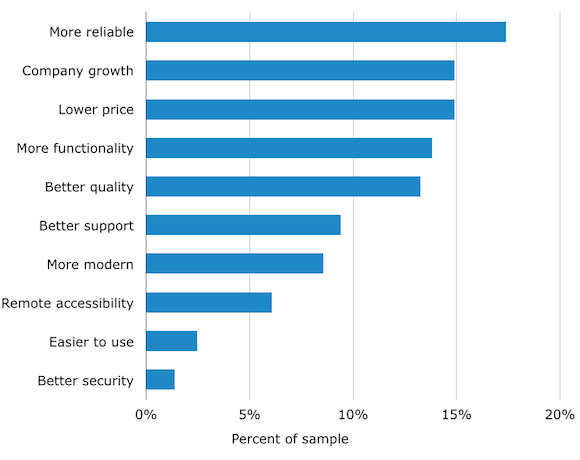Over the past few years, we’ve helped lots of clients switch to VoIP phone systems. While the reasons for making the switch vary widely, the primary concerns are always the same: Quality and reliability.
Our friends at Software Advice recently surveyed 200 respondents using VoIP for business, and asked them about the reliability of their systems. They found some interesting results.
Reasons for switching to VoIP
VoIP offers many advantages over traditional phone systems, and our clients have many different reasons for considering the switch. These reasons include:
- Enhanced reliability, from using a data network that’s easier to maintain than a traditional PBX;
- Improved scalability and reduced price, from an infrastructure where expansion is as easy as plugging in a new phone and modifications are done via web-based control panel
- Greater functionality, including auto-attendants, find-me/follow-me call forwarding, and voicemail-to-email
Top reasons for switching to VoIP

While our clients all have different motivations for considering the move to VoIP, their hesitation is almost always the same.
Primary concerns when considering the move to VoIP
In the first conversation about VoIP, we often get the same 3 questions:
- How’s the quality, will it echo?
- Can my internet handle it?
- What happens if my internet goes down?
A recent survey asked 200 people using VoIP phones for business which of their “everyday, online activities” were most often impacted by network issues. Notice how low on the list internet phone calls fell.
Everyday online activities affected by network problems

Voice calls were the least likely online activity to be affected by network problems. Even videoconferencing was less likely to see problems than everyday web browsing. This may seem surprising, but there are a few facts that explain it:
- Voice calls carry very little data, and require very little bandwidth. Web-based applications (software-as-a-service, online file editing, etc…) carry much heavier loads, and are much more likely to be affected.
- It’s very easy ensure Quality of Service (QoS), by teaching your router that voice data is different – and more important – than any other data. A properly configured VoIP network will include “bandwidth reservation”, so that a certain percentage of your internet service is always reserved and available for voice calls, regardless of what else is going on.
- It’s even easier to physically separate or duplicate the networks. When clients require larger numbers of workstations, we can easily place the phones on a completely separate network with a small internet connection, or merge two internet connections onto a single network to ensure redundancy and availability.
The concerns about VoIP are valid, but easily addressable by a team that knows what they’re doing. This is reflected in the following two charts, which show the likelihood of experiencing network problems contrasted with the availability of IT resources.
[row] [one_third]
Frequency of network issues
[/one_third]
[one_third]
Availability of IT resources
[/one_third][/row]
The percentage of respondents that have no IT resources often have network problems
Conclusions
The survey results lead to one overarching conclusion: There is no reason for a properly configured and maintained VoIP system to experience quality or reliability issues. However, emphasis must be placed on the properly configured aspect. Bandwidth reservations, QoS, redundant internet, and PoE networking are just a few of the considerations that need to be taken into account.
[blockquote]By differentiating vital business application traffic from traffic generated by employees’ personal activities, organizations can avoid the problems with Web-based applications that were widely reported by our sample and improve the performance of their voice networks across sites.[/blockquote]
VoIP can reduce costs, improve functionality, and add scalability to your business. Where IT support resources are available, network problems are rare and voice calling is the least likely component to be adversely affected.




